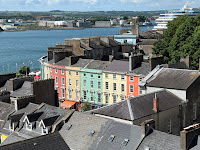Cork, Ireland - June 1, 2025
Our day began with an engaging historical walking tour in Cork, led by a charismatic and humorous guide who brought centuries of Irish history to life. Our day started off rainy, but quickly turned sunny, then rainy, then sunny, etc.
Our guide explained that the Celts first settled in Cornwall, the only part of England they occupied, before sailing to Ireland around the 7th-9th centuries BC. They brought their history, heritage, and culture, including two significant contributions:
- The Irish Language (Gaeilge) - Our guide humorously explained why Irish is so difficult to learn: it consists of all the languages and dialects the Celts collected during their travels across Europe. As he put it, "we were left to sort it out" because "every country they visited" contributed dialects. He described it as "57 other languages, everything and anything" depending on what part of Ireland you're in. His advice: "If you haven't been raised into Irish language, don't try now. You won't live long enough!"
- Ancient Customs - Including the practice of "sacrificing young maidens," which the guide jokingly assured everyone "we don't do that anymore," adding that making it illegal was helpful for "all the females."
In the 5th to 7th centuries A.D., the Vikings arrived from the North Sea with their trademark approach: "rape, rob, plunder, and pillage - they were experts." They recognized Cork's harbor as strategically valuable and "didn't take any prisoners." After establishing themselves, they moved to Cork city, then returned about 25 years later for a "repeat performance."
 |
| Panoramic of the Harbor Area |
 |
| Titanic Replica |
The ship Carpathia rescued 705 Titanic survivors who reached New York. Later, the ship Mackay-Bennett was sent to recover bodies. Of over 300 bodies recovered, they could only embalm about 100 due to limited supplies in Halifax, Nova Scotia. The class distinctions continued even in death: the first class passengers were place in wooden coffins while the 3rd class passengers were placed in body bags or whatever was available.
 |
| Lusitania Memorial |
The original Cunard Shipping Line headquarters were in Cork. Cunard owned not only the Lusitania but also the Queen Elizabeth and the Queen Mary.
 |
| Annie Moore |
I loved the brightly painted houses and the potted flowers scattered throughout the town.
Construction on the cathedral began in 1868 but the cathedral was not completed until 1919 due to increases in costs and revisions to plans. However, by 1879, it was sufficiently completed to allow the congregation to gather and celebrate mass.
One of the cathedral's most remarkable features is Ireland's only carillon, which with 49 bells is the most of any in the British Isles. It contains Ireland's largest bell, named St Colman, which weighs 3.6 tons.
We ended our day with a visit to the Heritage Center located next to the pier where there was information of life in Ireland during and the after the potato famine, the sinking of the Titanic and the sinking of the Lusitania.












Comments